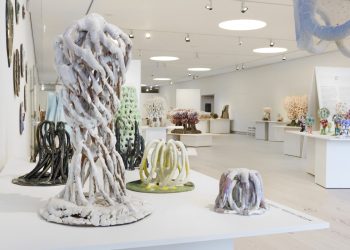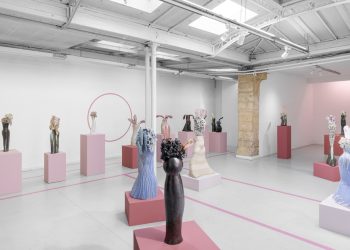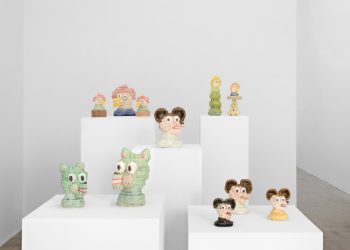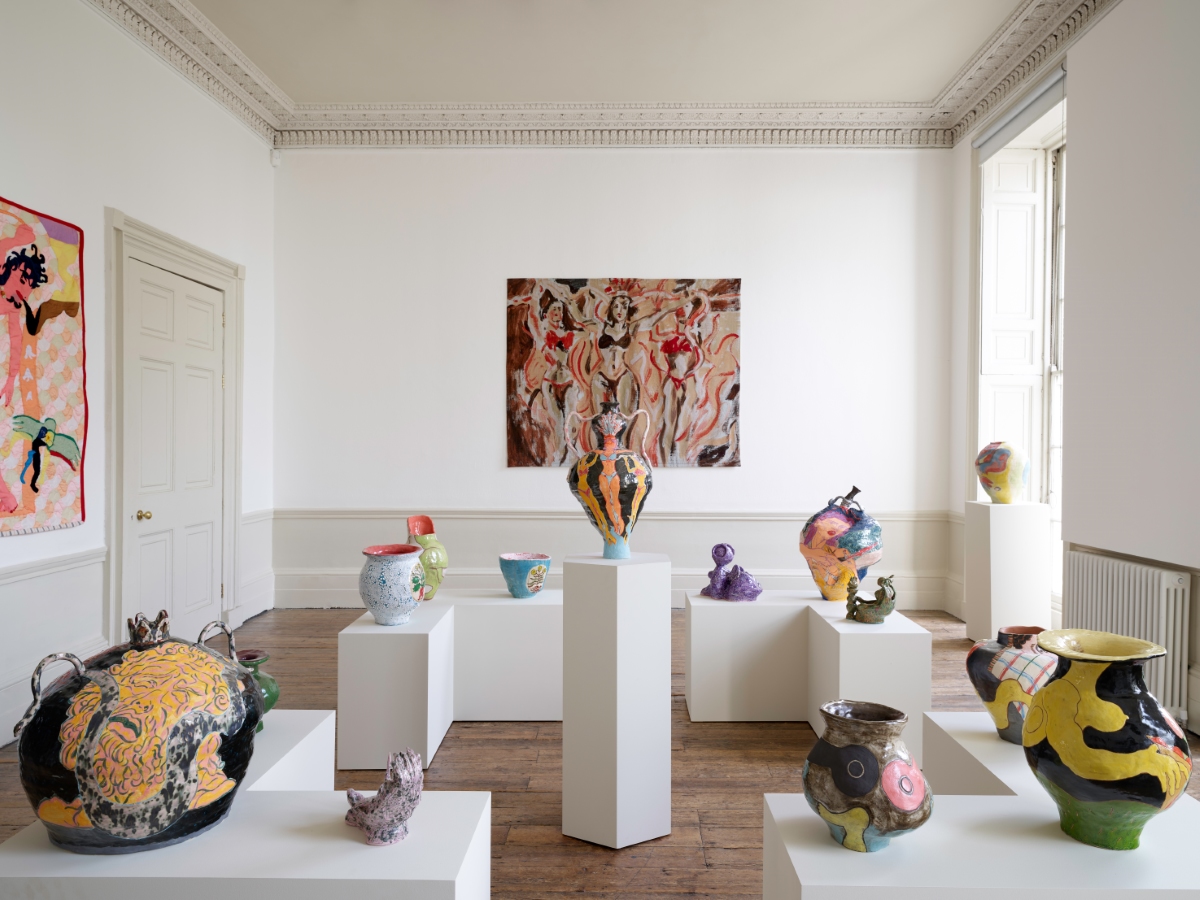
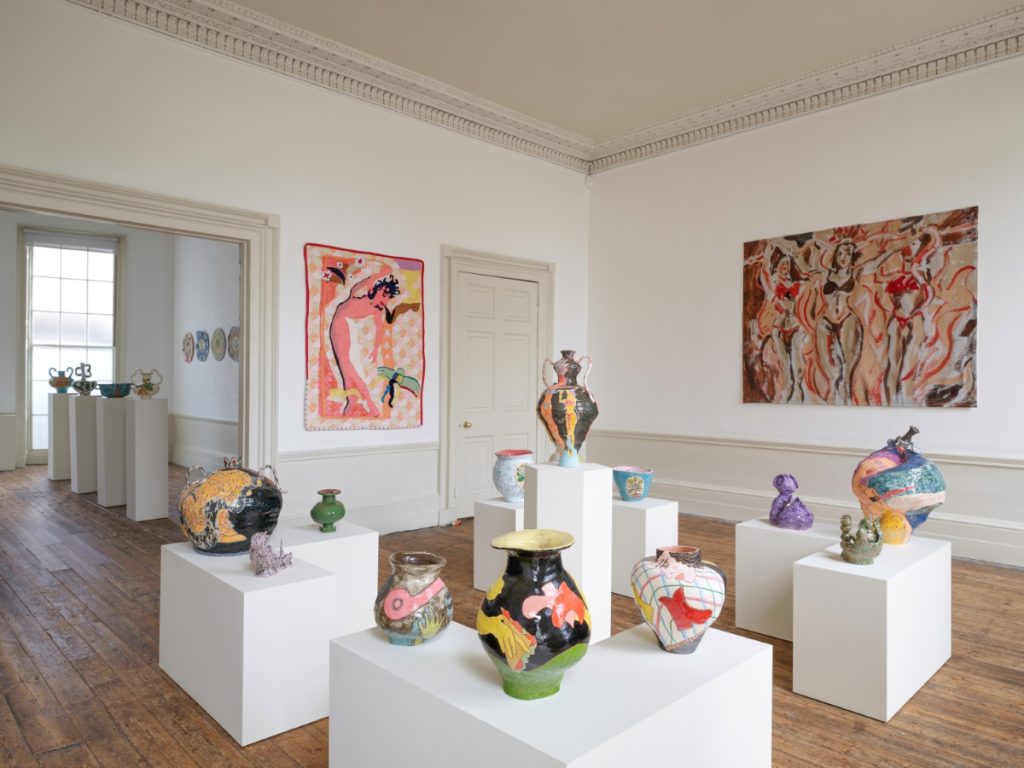
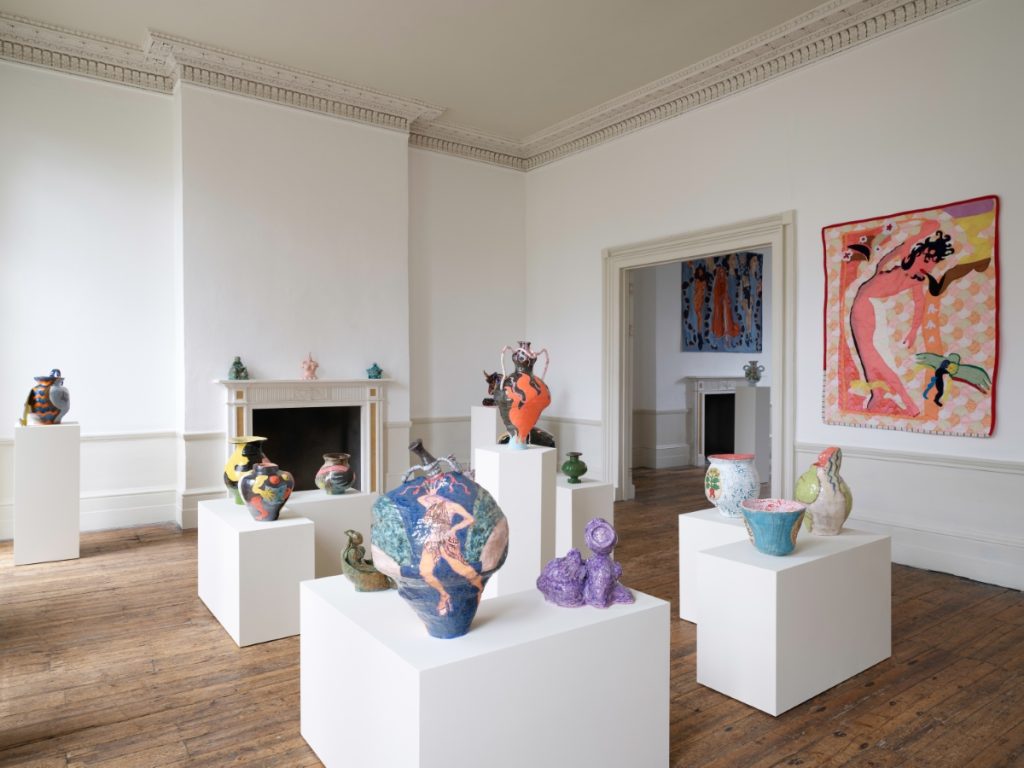
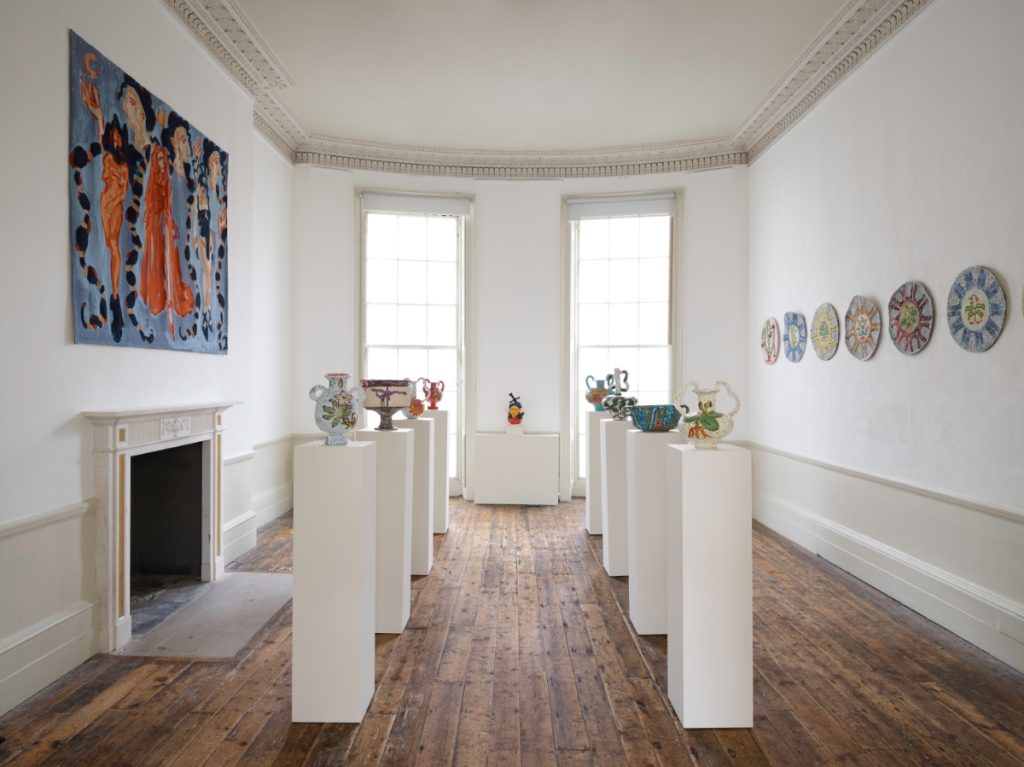
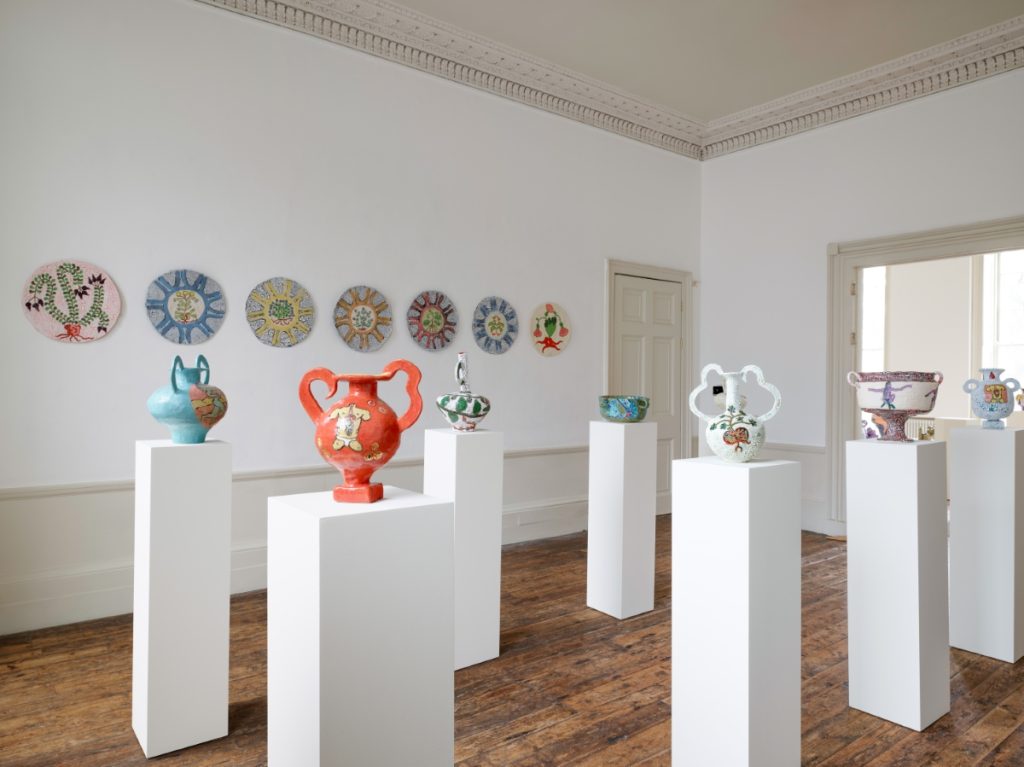
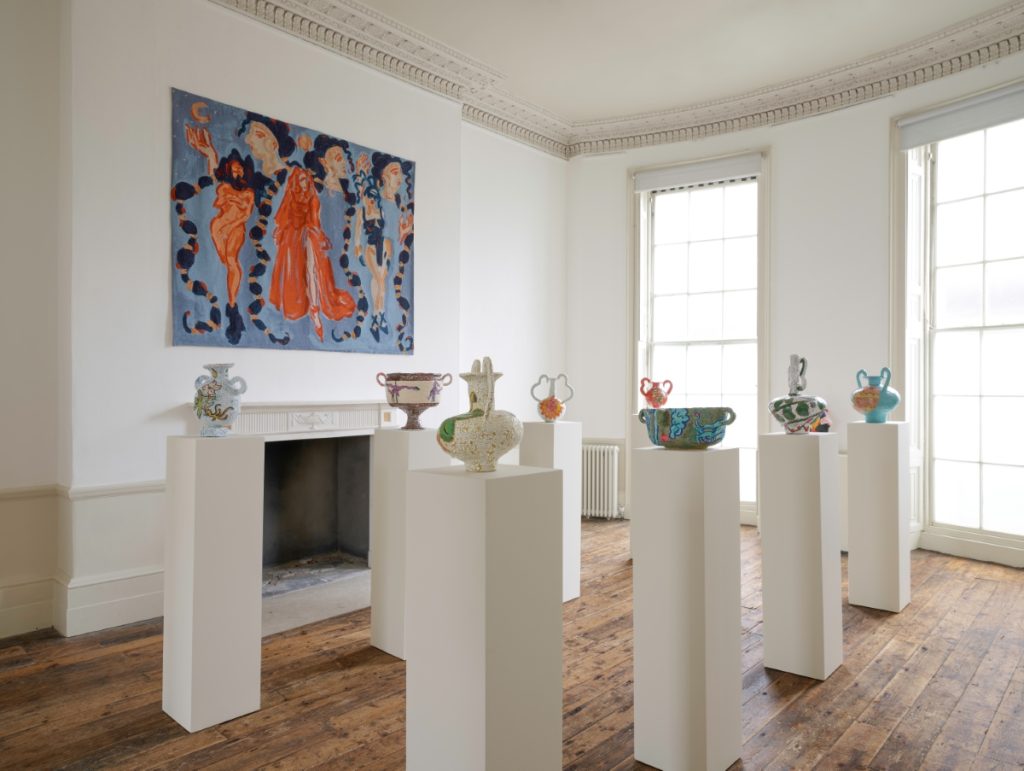
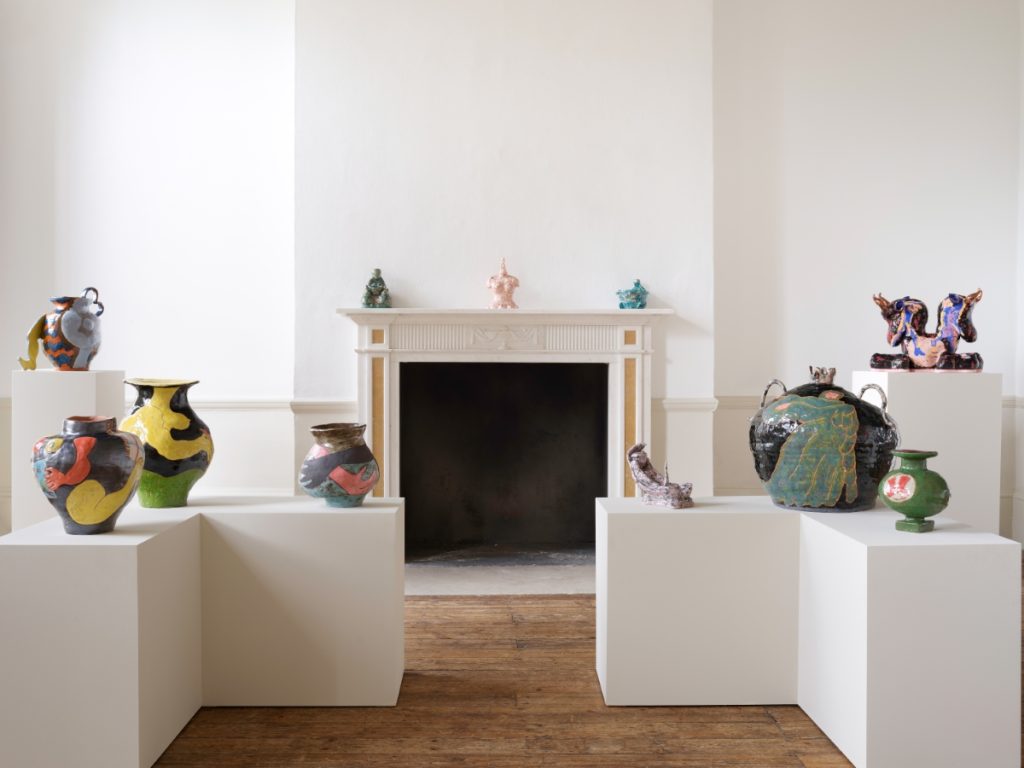
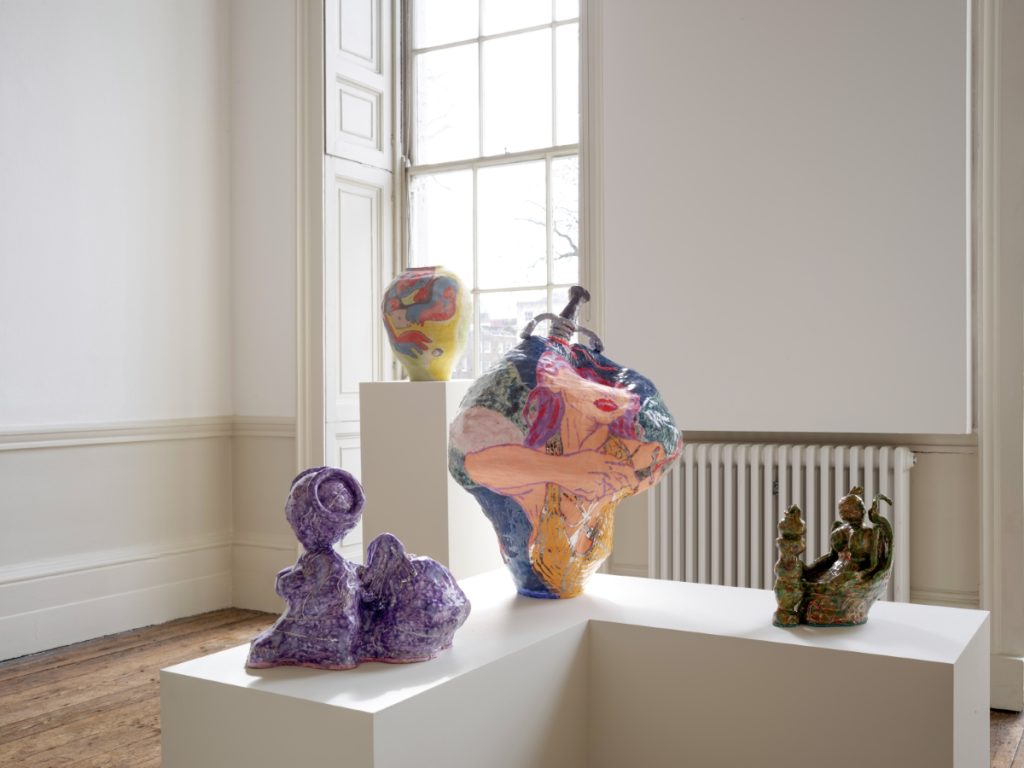
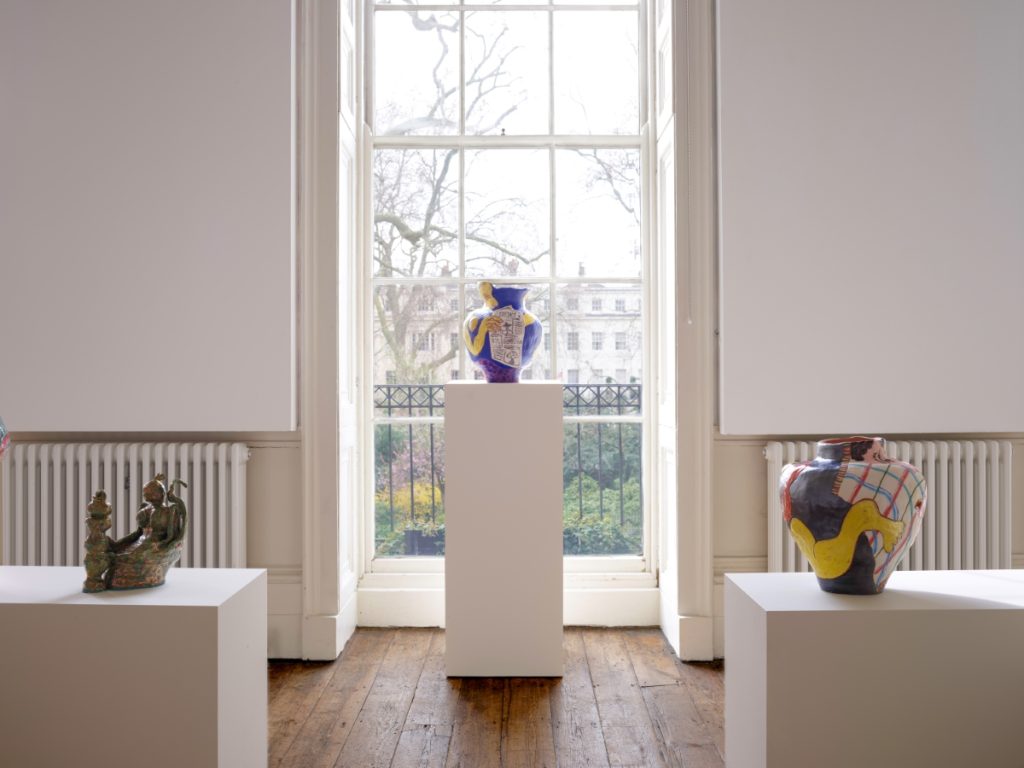
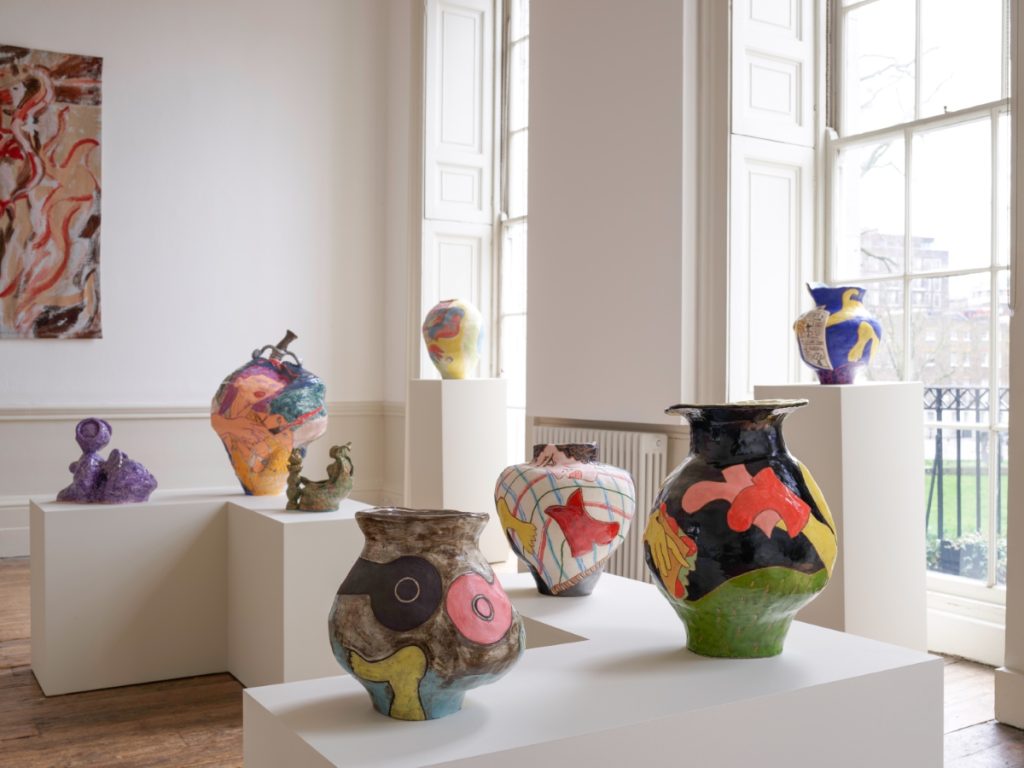
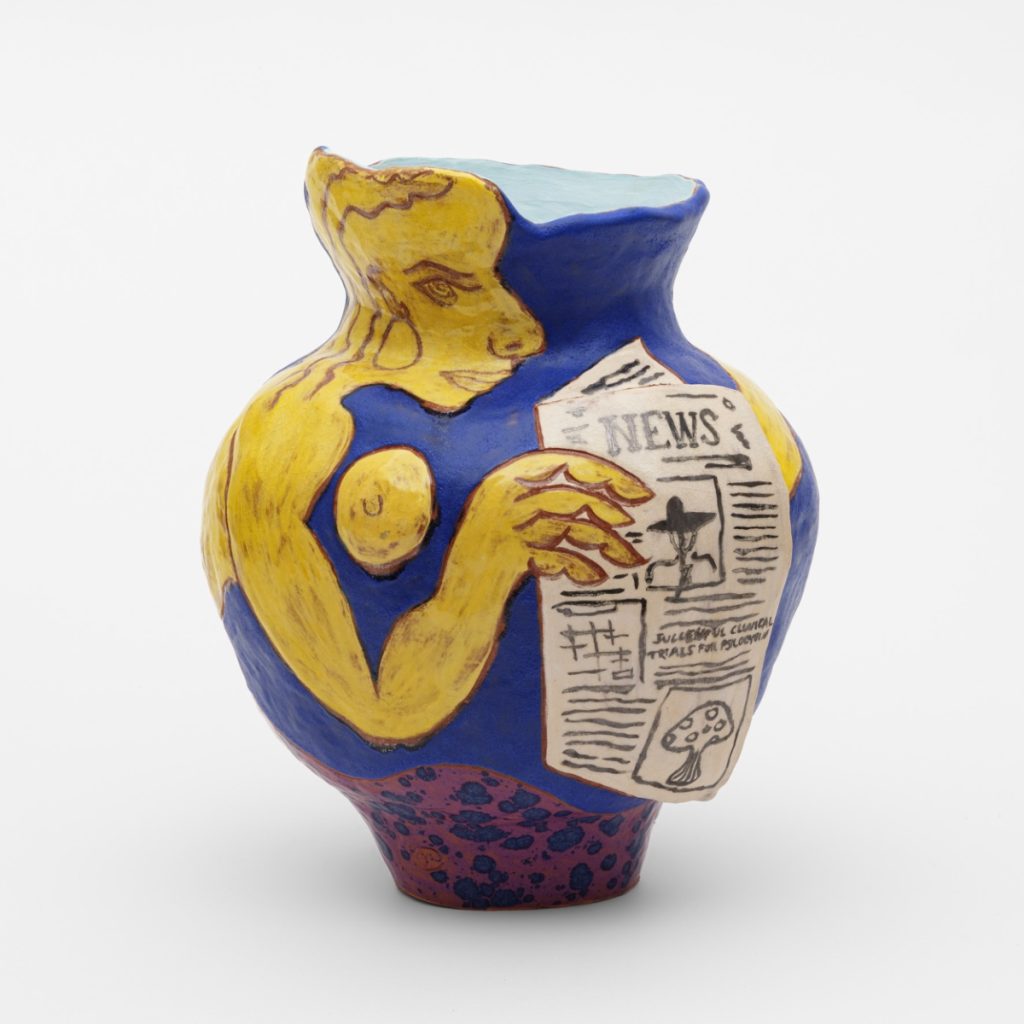
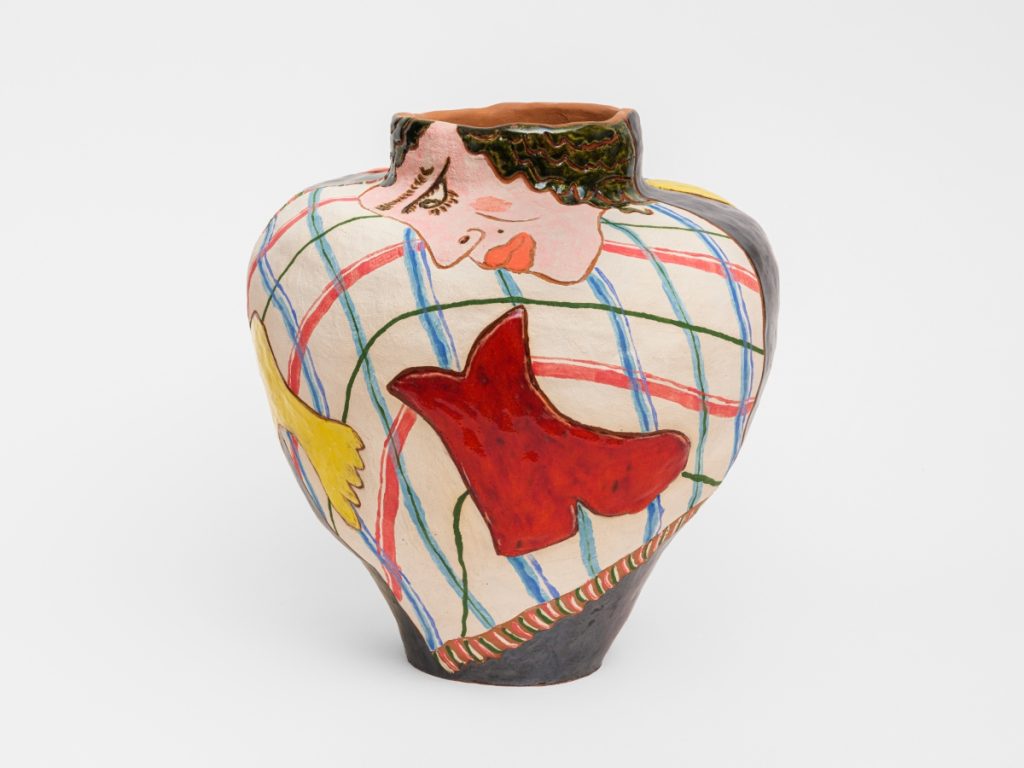
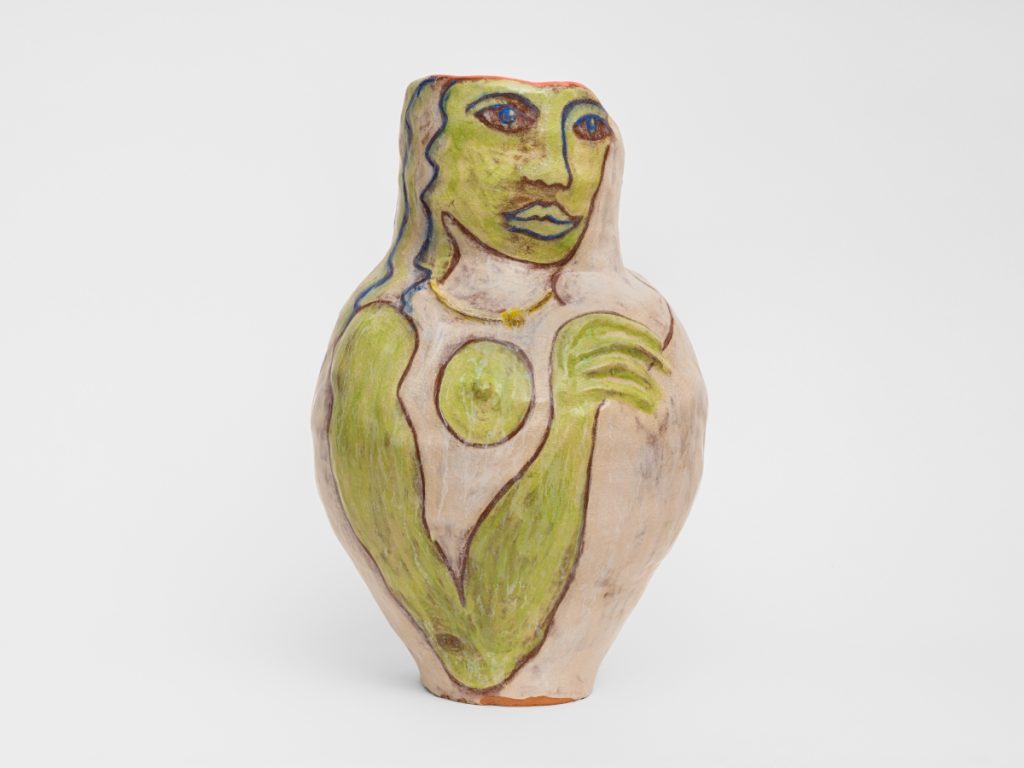
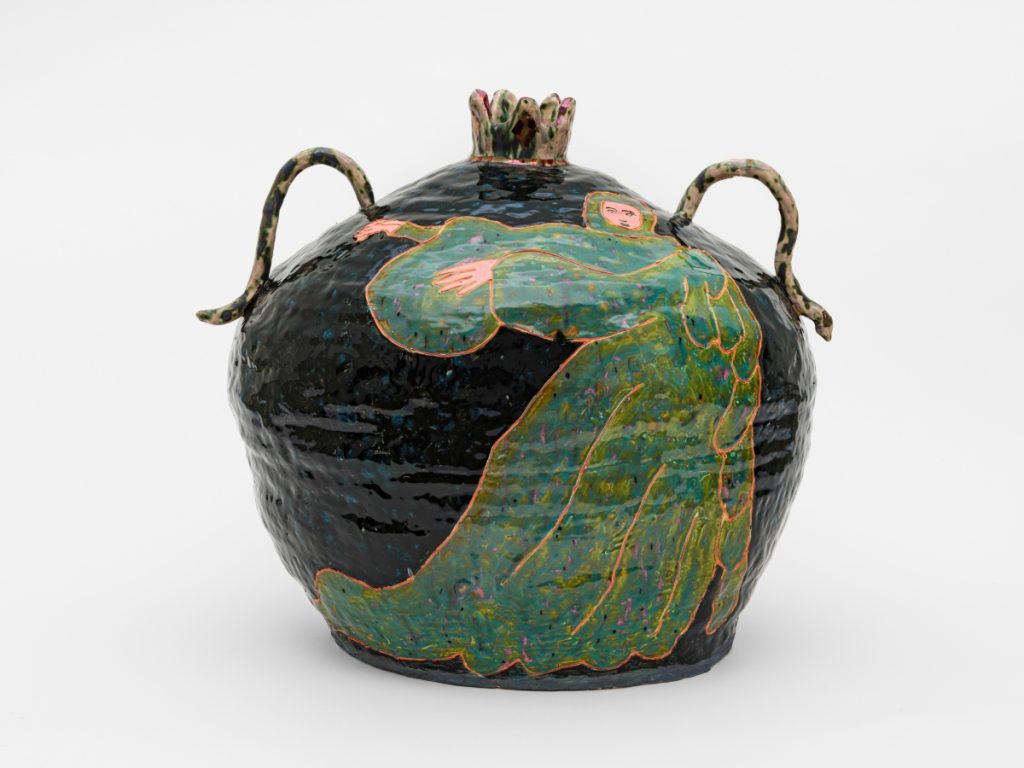
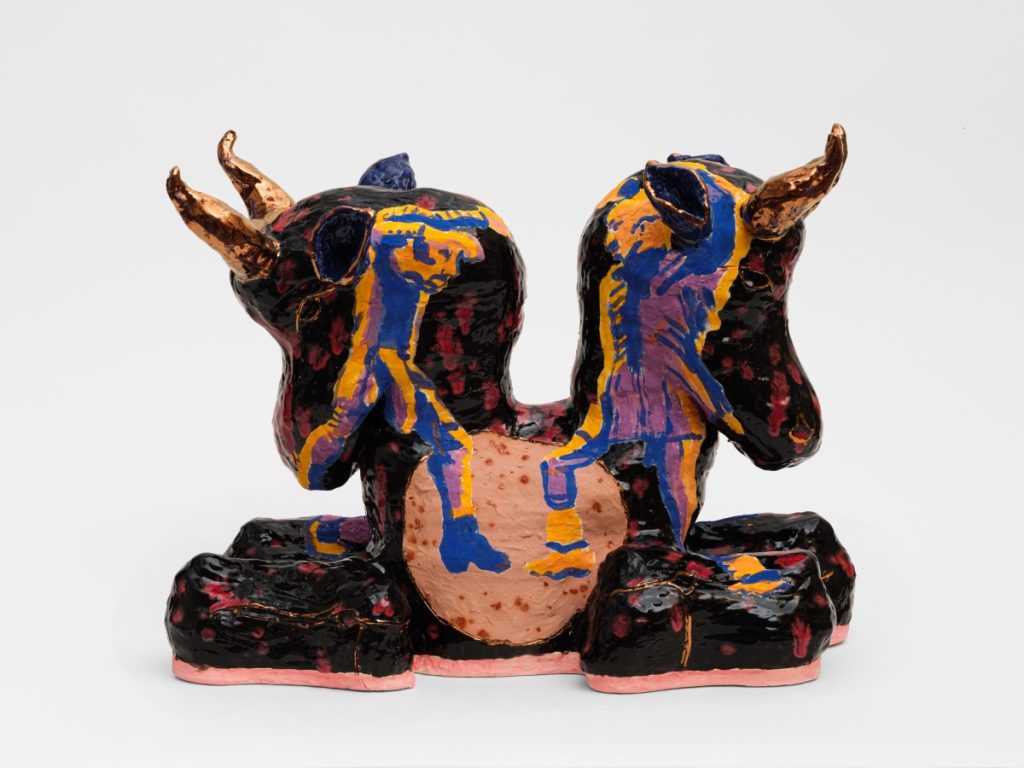
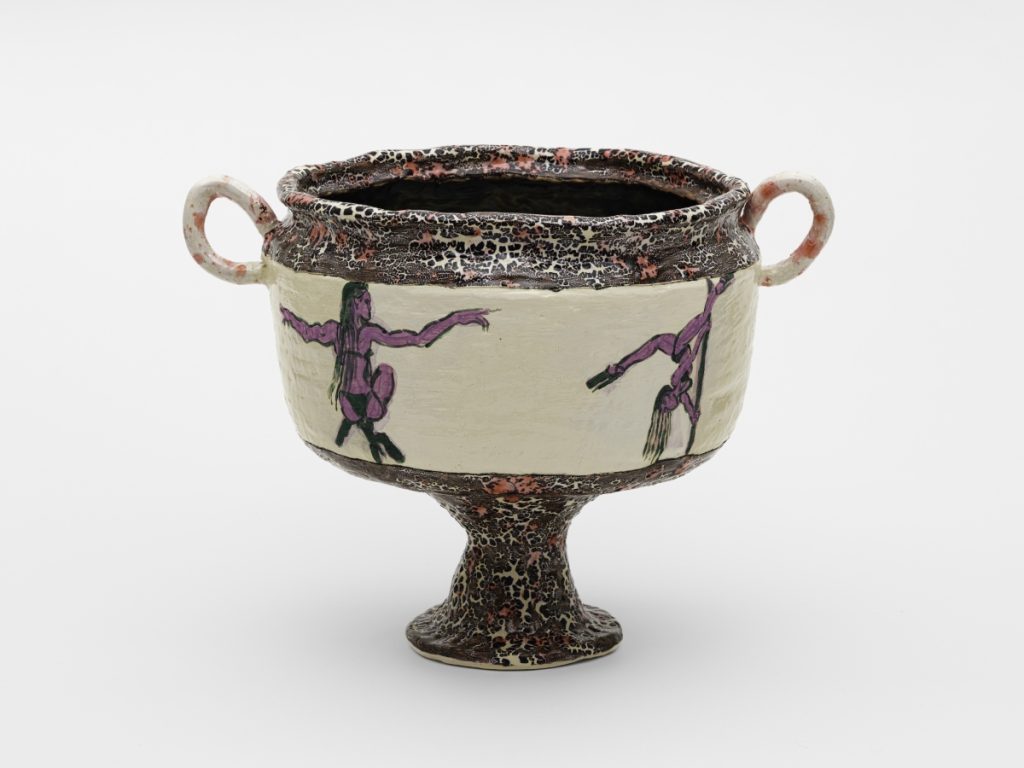
Christabel MacGreevy and Rafaela de Ascanio: Sexing the Cherry is on view at Tristan Hoare, London
March 23 – April 28, 2023
Tristan Hoare is delighted to announce a dialogue exhibition of ceramics and tapestries by London-based artists Christabel MacGreevy and Rafaela de Ascanio, first presented to our audiences in September 2021 as part of our ceramics group show Cracked.
Sexing the Cherry takes its point of departure from Jeanette Winterson’s 1989 postmodernist novel of the same name, which considers women’s roles, prominence, or lack of prominence in society within historical fiction. The novel focuses on the Twelve Dancing Princesses from the Brothers Grimm fairy-tale after their reluctant marriages and recounts their murderous revenge on their husbands, up-ending the original fable’s happy-ever-after. MacGreevy and de Ascanio’s joint show provides a chorus of voices in response to questions the novel poses, interweaving figures from ancient to pop cultures, literature, music and film into a multi-disciplinary body of work.
MacGreevy uses a range of techniques and materials to denote both the physical and psychological properties of her sculptural series; terracotta for her figurative vessels, durable and resilient to cracking like her characters themselves; light stoneware and bead glazes fired at high temperatures for wall-mounted medallions based on medieval depictions of plants and strange objects that carry a resonance of magical properties and healing power. The latter works evoke the dichotomy of the woman as witch, the artist as healer, the intertwining of the two. MacGreevy explores a woman’s role in society through her relationship to magic and the historical necessity of connecting to supernatural powers, as a means of control. Her graphic appliquéd figures which weave themselves around her curiously shaped vessels hold small clues indicative of a wider narrative, glimpses into the privacy of a life, their own lives, but also every life. “In the same way that Orlando defies gender and time and Hogarth’s Rake moves through his chaotic existence,” MacGreevy comments, “the figures on my vessels live out their lives, an expression of freedom, fluidity, and nonconformity.”
De Ascanio’s colourful sculptures and tapestries delve deep into the world of Winterson’s novel, exploring “the tensions within female idolatry, from the monotheist Minoan snake goddess to pop queens Bjork and Rosalía.” Using experimental glazes and lustres, de Ascanio sculpts her own Twelve Dancing Princesses, splicing art historical tropes and symbolism from Renaissance tarot cards, with iconic imagery from the films of Robert Rodriguez, Matteo Garrone, and cult music videos. Her colour palette is tropical (a nod to her early years spent in the Canary Islands) barely concealing heavier themes which emerge; cultural confrontations and females holding positions of dominance, threatening the status quo. De Ascanio’s painting practice finds its way into large-scale tapestries which will adorn the gallery’s walls, woven into life from works on paper which act as sketches for her ceramic sculptures. A beating heart, a double-headed bull/cow hybrid, a sphinx and a voluptuous female torso are all but a teaser of the variety of sculptural shapes in which de Ascanio manifests her contemporary princesses.
The artists’ shared love of artefacts and the history and possibility they carry within them allowed the collaboration to blossom. “We discussed how certain symbols are repeated across ancient civilisations, often presenting femininity as powerful, subversive, or a bit frightening. Taking these ideas and combining them with our own contemporary perspective offers them a different context and serves to show how the visual arts can reveal archetypes that still relate through thousands of years.” Sexing the Cherry ties together these strands, allowing the artists’ sculptured characters to move through time and space and assert themselves through violence, persuasion and magnetism. Human, flawed and animalistic, they are deeply likeable and relatable.
Sexing the Cherry will transform 6 Fitzroy Square into a maze of colour and storytelling, encouraging audiences to explore new and forgotten narratives, recounted by these two young artists in their signature bold and graphic styles.
Of what is a woman made? How might the expansive, slippery mechanisms of the self, the flickering of desire and flashes of emotion, be expressed through the rigid, durable stuff of ceramics? In a misogynistic society, what can we learn from revisiting traditions in which women’s grace was longed for, their magic coveted?
Taking inspiration from Jeanette Winterson’s 1989 novel, Sexing the Cherry, where the Twelve Princesses from the Brothers Grimm fairy-tale are tracked down after their reluctant marriages, their murderous revenge on their husbands is recounted, up-ending the original fable’s heteronormative happy-ever-after, Christabel MacGreevy and Rafaela de Ascanio’s joint show Sexing the Cherry provides a chorus of voices in response to these questions, interweaving figures from ancient cultures to pop culture, myth, literature, music and film into a multi-disciplinary body of work richly inflected with feminist and queer thought.
Women gaze out of vessels that possess the resonance of sacred totems. Some resemble deities tasked with our protection, others simmer with a violent avenging intent. Bloody knives are brandished; hearts are eaten; heads lopped off. Others still are driven by pleasure, in the simplicity of a sandwich or in the blissful transcendence offered by dance. None aspire to prettiness, yet they inspire devotion. At their most seductive, they are instruments of goddess worship rather than erotic objects to be consumed by men. Don’t be fooled by their floral dresses, bikinis, flaxen hair and lipstick: femininity is an armour, a camouflage, rather than a concession to dreary societal norms. They are unplaceable in time, as though adventuring from one era to the next in the most inconspicuous costume available, a form least likely to draw notice because considered unimportant: an ordinary woman’s body.
Imagine an archaeological site in which the city under excavation had for centuries been ruled over by women. Each layer of soil reveals traces of a civilisation in which their voices resounded loudest, their thoughts and emotions became celebrated cultural artefacts, their forms of knowledge and modes of self-expression were circulated as fact and preserved as history. This is a fantasy: women emerge as fragmentary presences in antiquities and the historical archive if they do so at all. Yet these ceramic vessels, medallions and tapestries, with their allusions to mysticism, herbal medicine, votive figures, newly dynamic feminine archetypes, and traditionally female-led practices, evoke a world in which such a society were possible. For generations, women’s attempts to access power have been met with obstruction and oppression. Yet there were always those willing to risk it all in acts of defiance. These instances in which women seized back control – real and imagined – unite MacGreevy and de Ascanio’s work. MacGreevy adorns medallions with botanical drawings that cite and subvert their medieval source texts, and which celebrate the denigrated systems of thought developed by women healers. For de Ascanio, sphinxes, serpents and sacred bulls, animals and hybrids which share a contested relationship to privilege, become women’s natural companions, their co- conspirators in ritualistic performance and sensual indulgence.
In her novel, Winterson lengthens and enriches the young brides’ lives, a response to the narrowness of women’s horizons across time, a reality reinforced by their representations in culture. She was not the first to attempt this act of hope, and of care. Virginia Woolf’s 1928 novel Orlando imagines its protagonist defying death and binary gender for over 300 years in a life of hedonistic excess and celebrity as both a man and a woman. Nor was Winterson the last. De Ascanio and McGreevy’s inventive, compassionate works take up this responsibility, pulling women from the wreck over centuries of frustrated ambition and foreshortened existence, and dream up for them another future.
Christabel MacGreevy (b. 1991) is a British interdisciplinary artist concerned with myth, love, and memory explored through folklore, art history and personal mythology. MacGreevy is best known for a bold drawing practice with an emphasis on pattern, colour and graphic lines lending itself to an expanded practice which includes collage, printmaking, textiles and more recently, sculpture. MacGreevy’s works explore ideas of memory, identity and the human inclination to transform the significance of the inanimate, or overlooked object into a personal shrine.Storytelling and an idiosyncratic iconography are used to express what we may struggle to describe in words: identity, masculinity, femininity.
Rafaela de Ascanio (b. 1986) is a London-based artist whose colourful paintings and ceramics playfully reimagine art historical tropes, symbolism from Renaissance tarot cards, landscapes from mythological painting, and compositions from Egyptian friezes. Appropriating the reverence of canonical imagery, de Ascanio paints and moulds stories depicting her contemporaries, reimagining ancient narratives with female protagonists. While these characters are portraits of artists and performers, their deification as female warriors, witches and goddesses imbue them with individual talismanic powers from creation and fecundity to strength and rebirth.
Tristan Hoare
Founded in 2009, TRISTAN HOARE is a multi-layered gallery focusing on young and established artists working in a variety of mediums. African photography, glass, painting and drawing are all areas of interest, as well as a developing passion for ceramics.
Each year we curate an ambitious exhibition with an overarching theme. Geometrica (2018), Botanica (2019), Folds (2021) and The Conference of the Birds (2022) enabled us to collaborate with multiple artists and galleries, combining work from BC to the present day. Exhibitions are executed with the intention of telling a story and connecting with both seasoned collectors and people less familiar with the art world.
Contact
info@tristanhoare.co.uk
Tristan Hoare
6 Fitzroy Square
London, W1T 5DX
United Kingdom
Installation images by Peter Mallet



